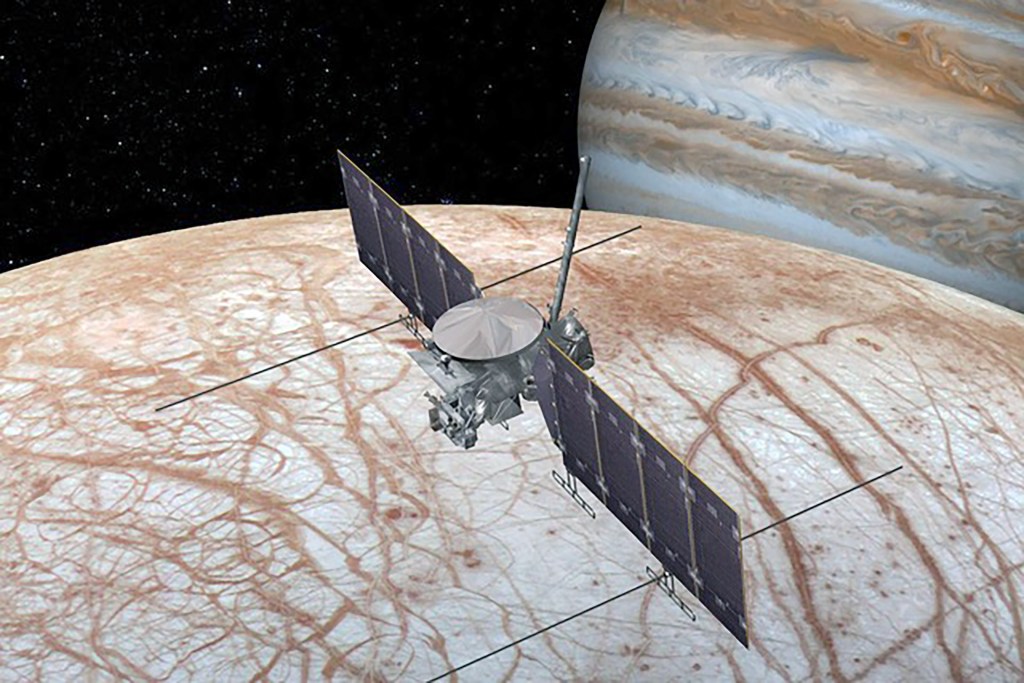OUR SPACE: Godspeed, Europa Clipper!
Published 9:30 am Tuesday, October 8, 2024

- Europa Clipper with Jupiter
The day is almost here when Nasa’s newest flagship mission will launch on its long trip to Jupiter’s mysterious moon Europa. The period of daily launch windows will start on Thursday October 10, and if something doesn’t look right it’s not such a big deal – there are daily opportunities to get this absolutely massive spacecraft off the planet.
Europa Clipper is the largest spacecraft NASA has ever built for a planetary mission – and there are good reasons for its size. It’s larger than a basketball court – 100 by 58 feet – mostly due to its enormous solar panels. Jupiter and its moons are a very long way away from the sun, and there’s not a lot of sunlight to generate electricity for the spacecraft’s heaters and science instruments. Size really does matter when it comes to solar panels!
Trending
The spacecraft itself is built as sturdy as a tank. Jupiter is not a very explorer-friendly planet – its radiation environment is an absolute killer for delicate electronics, so all the hardware must be radiation-hardened and protected extremely well. Jupiter’s magnetic field is about 20,000 times stronger than Earth’s, and that’s enough to mess up anything with electronic components. While Europa Clipper’s target is of course Europa, the spacecraft will actually go into an elliptical orbit around Jupiter that will take it past Europa dozens of times – giving it plenty of time to do all of its observations. This orbit takes it out of the danger zone most of the time, thus greatly increasing the life span of the spacecraft. An orbit around Europa would keep Europa Clipper in the high radiation environment the entire time and it would last only a few months,
But why Europa to begin with?
Europa is almost certain to contain a vast subsurface ocean. Past observations have discovered a solid ice crust that keeps getting pushed and pulled by Jupiter’s enormous gravity, thus creating cracks and canyons on the surface. There is water, minerals and energy hidden underneath the thick ice cover – all conditions that are conducive to the development of life. While Europa Clipper won’t be able to detect life on Europa, it will be able to find all the elements that are necessary for it. While every space-based science fiction show seems to have a “life sign scanner” that can check an entire planet within seconds, in reality such a device doesn’t exist, at least not yet, and what exactly does that scanner observe anyway? An actual confirmation will be left to a future mission that can drill a hole through the ice and send a submarine down for samples and analysis.
Europa Clipper carries nine science instruments and a gravity experiment which will all work at the same time during each pass, each observing the moon in their own way so that later scientists will be able to overlay all the results for a detailed picture. And it will be a international pictures as almost 4000 people from all over Europe and the United States have in some way contributed to the mission, from early concepts to the development and construction to the software and communication systems.
In order to keep the mission budget within specs the spacecraft will not head straight to Jupiter but instead use a complicated series of gravity assists, also known as slingshot maneuvers to reach the required trajectory and speed to make it to its goal by around 2030. It will take a journey of 1.8 billion miles and visits to Mars and Earth to get there.
Hopefully a few of you are coming along for the ride – those that sent their name in the special “Message in a Bottle” initiative about a year ago. 2.6 million names are included on a special plate that also contains graphics of sound files and poetry. And there are still plenty of ways you can get involved right now – from kid’s art to Europa-inspired clothing choices. Everyone can support this mission and participate – check out the various projects at https://science.nasa.gov/mission/europa-clipper/participate/ !
Trending
Europa Clipper will launch atop a SpaceX Falcon Heavy from Kennedy Space Center, and it will be an impressive sight; the noise of the giant triple-rocket will be audible as far as Daytona Beach, over an hour’s drive away. We’ll keep our fingers crossed that everything goes as planned and the weather holds up. Hurricane season is not over yet, and more tropical disturbances are forming over the Atlantic all the time.
Meanwhile – let’s hope we get a good launch this week, or whenever it will happen this month, so keep your eyes peeled on the Europa Clipper website for all the latest updates!
Beate Czogalla is the Professor of Theater Design in the Department of Theatre and Dance at Georgia College & State University. She has had a lifelong interest in space exploration and has been a Solar System Ambassador for the Jet Propulsion Laboratory/ NASA for many years. She can be reached at our_space2@yahoo.com





